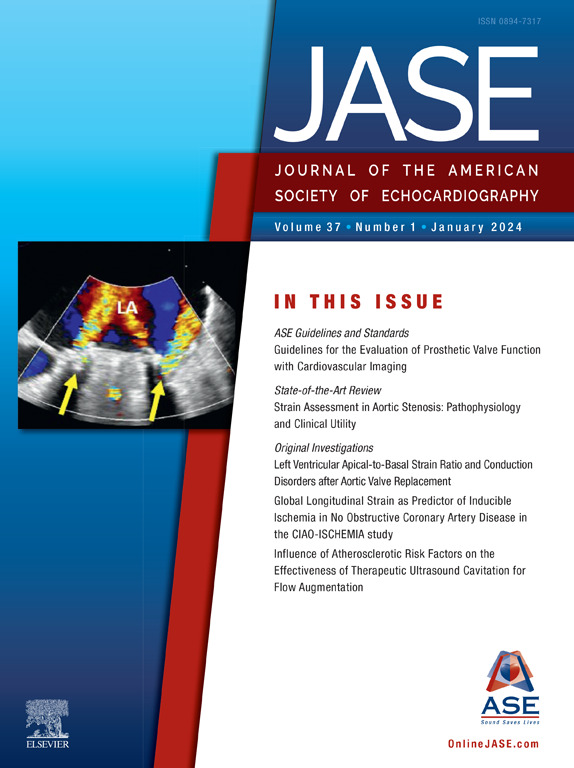Effect of Detection of Subclinical Atherosclerosis on Carotid Ultrasound on Cardiovascular Events in a Primary Prevention Clinical Setting
IF 6
2区 医学
Q1 CARDIAC & CARDIOVASCULAR SYSTEMS
Journal of the American Society of Echocardiography
Pub Date : 2025-10-01
DOI:10.1016/j.echo.2025.06.009
引用次数: 0
Abstract
Background
The relative contribution of common carotid artery (CCA) intimal medial thickness (IMT), carotid bifurcation plaque presence, and its burden in predicting cardiovascular disease (CVD) events in a primary prevention clinical cohort remain unclear.
Aims
To assess the usefulness of distal far wall of right and left CCA IMT assessment (in the absence of carotid bifurcation plaque) and plaque presence and plaque number on incident CVD in a primary prevention clinical setting.
Methods
Observational study of consecutive 1,903 patients free of known CVD clinically referred for right and left carotid bifurcation two-dimensional ultrasound for subclinical atherosclerosis assessment between 2007 and 2014 at a single center. Incident composite CVD (cardiac death, myocardial infarction, unstable angina, and ischemic stroke) was compared between patients with and without plaque (defined as focal or diffuse medial-adventitial border to luminal border thickening of ≥1.5 mm), with increasing plaque number and with increasing CCA IMT percentiles (<25th, 25th-49th, 50th-74th, and >75th centiles) adjusted for atherosclerotic CVD scores using Pooled Cohort Equation and Framingham Risk Score in the absence of bifurcation plaque.
Results
The final study cohort contained 1,569 patients (mean age, 55.1 ± 8.6 years; female, 36%) after study exclusions with a mean follow-up of 9.8 ± 5.5 years. Eight hundred fifty-nine (54.7%) had carotid plaque, and 710 (45.3%) had no plaque. Incident composite CVD occurred in 90 (5.7%) patients, with no difference in patients with and without plaque (hazard ratio [HR] = 1.19; 95% CI, 0.78-1.82; P = .425) or with ≥75th versus <75th IMT percentile in the absence of plaque (HR = 1.35; 95% CI, 0.64-2.85; P = .431). Increased incident CVD events occurred in patients with 3 or more plaques versus no plaque (HR = 2.9; 95% CI, 1.48-5.65; P = .002), which remained significant after adjusting for the Pooled Cohort Equation (HR = 2.45; 95% CI, 1.13-5.3; P = .023) and Framingham Risk Score. Patients with IMT centile ≥75% and presence of carotid plaque received increasing new statin prescriptions after carotid ultrasound result. Significant low-density lipoprotein cholesterol reduction (19.3 ± 25.7 mg/dL; P < .001) on follow-up occurred only in patients in whom plaque was identified.
Conclusions
The number of carotid bifurcation plaques on carotid ultrasound is associated with incident CVD in a primary prevention cohort. Given the referral nature of the study cohort, evaluation of only carotid vascular bed, and increased statin prescriptions after carotid ultrasound result, our findings regarding the lack of prognostic value of CCA IMT or of any plaque should be interpreted with caution. Presence of plaque on carotid ultrasound led to increased statin prescriptions and greater low-density lipoprotein cholesterol reduction on follow-up. This clinically useful and simple method can be adopted in clinical practice for CVD risk stratification.
颈动脉超声检测亚临床动脉粥样硬化对心血管事件一级预防的影响
背景:在一级预防临床队列中,颈总动脉(CCA)内膜内侧厚度(IMT)、颈动脉分支斑块存在及其在预测心血管疾病(CVD)事件中的负担的相对贡献尚不清楚。目的:评估右(右)和左(左)CCA远端远壁IMT评估(在没有颈动脉分叉斑块的情况下)、斑块存在和斑块数量在初级预防临床环境中对CVD事件的有用性。方法:观察性研究2007-2014年连续1903例无已知心血管疾病临床转诊的颈动脉左、左分支二维超声进行SA评估的患者。比较有斑块和无斑块患者(定义为局灶性或弥漫性内外边界至腔内边界增厚bbb1.5 mm)的复合心血管疾病(心源性死亡、心肌梗死、不稳定型心绞痛和缺血性卒中),斑块数量增加,CCA IMT百分位数增加(th, 25-49,使用合并队列方程(PCE)和Framingham风险评分(FRS)在没有分叉斑块的情况下调整动脉粥样硬化性CVD评分为第75位。结果:最终研究队列为1569人(平均年龄55.1±8.6;女性36%),平均随访时间为9.8±5.5年。859例(54.7%)有颈动脉斑块,710例(45.3%)无斑块。90例(5.7%)患者发生了复合心血管疾病,有斑块和没有斑块的患者没有差异(HR 1.19, 95% CI 0.78-1.82, P=0.425),没有斑块时bbb75对< 75 IMT百分位数(HR 1.35, 95% CI 0.64-2.85, P=0.431)。在校正PCE (HR 2.45, 95% CI 1.13-5.3, p=0.023)和FRS后,有3个或更多斑块的患者与无斑块的患者相比,心血管疾病事件发生率增加(HR 2.9, 95% CI 1.48-5.65, p=0.002)。颈动脉超声检查结果后,IMT百分位> = 75%且存在颈动脉斑块的患者接受的新他汀类药物处方增加。结论:在一级预防队列中,颈动脉超声显示的颈动脉分叉斑块数量与心血管疾病的发生有关。考虑到研究队列的转诊性质,仅评估颈动脉血管床和颈动脉超声结果后增加他汀类药物处方,我们关于CCA IMT或任何斑块缺乏预后价值的研究结果应谨慎解释。颈动脉超声显示斑块导致他汀类药物处方增加,随访时LDL-c降低幅度更大。该方法简便实用,可用于临床心血管疾病危险分层。
本文章由计算机程序翻译,如有差异,请以英文原文为准。
求助全文
约1分钟内获得全文
求助全文
来源期刊
CiteScore
9.50
自引率
12.30%
发文量
257
审稿时长
66 days
期刊介绍:
The Journal of the American Society of Echocardiography(JASE) brings physicians and sonographers peer-reviewed original investigations and state-of-the-art review articles that cover conventional clinical applications of cardiovascular ultrasound, as well as newer techniques with emerging clinical applications. These include three-dimensional echocardiography, strain and strain rate methods for evaluating cardiac mechanics and interventional applications.

 求助内容:
求助内容: 应助结果提醒方式:
应助结果提醒方式:


